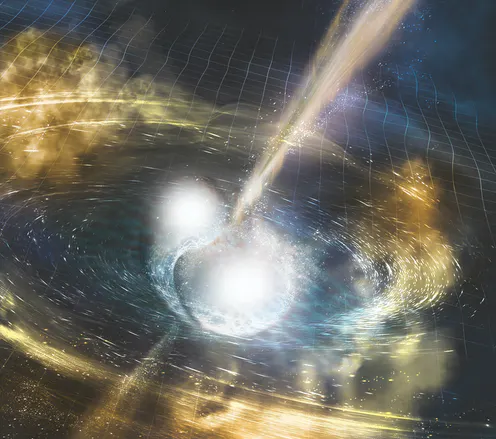
From the translator:
This article is a kind of announcement of the possible. Professor David Blair summarizes the scientific work paving the way for increasing the sensitivity of gravitational wave detectors by 40 times or more. In practice, this announcement means that soon we will probably see completely different popular science programs about space. And this, of course, is just the cherry on the cake. The detectors are an order of magnitude more sensitive - this is new knowledge about the physics of space. The perspective is mesmerizing, so I could not help but translate this text and share it.
In 2017, astronomers witnessed the birth of a black hole for the first time. Gravitational wave detectors picked up the ripples in spacetime caused by the collision of two neutron stars that formed a black hole, and then other telescopes observed the result - an explosion.
But the real details of how the black hole formed, the details of the movement of matter moments before it was hidden within the event horizon, went unnoticed. This happened because the gravitational waves thrown out in these last moments had a frequency so high that today's detectors do not catch them. If you could see how ordinary matter turns into a black hole, then it would be something similar to the Big Bang, but in the opposite direction. Scientists who design gravitational wave detectors have worked hard to figure out how to increase the sensitivity of the detectors and be able to observe the transformation of ordinary matter into a black hole.
Today our team is publishing an article, which explains how to increase the sensitivity of the detectors. The proposed solution could make detectors 40 times more sensitive to the high-frequency waves we need, allowing astronomers to listen to matter as it forms in black holes. We are talking about the creation of new unusual energy packets (or "quanta"), which are a mixture of two types of quantum vibrations. To achieve the required sensitivity, devices based on this technology can be coupled with existing gravitational wave detectors.
Quantum problems
Gravity detectors like the Laser Interferometer Gravitational-wave Observatory in the United States use lasers to measure incredibly small changes in the distance between two mirrors. The effects of quantum mechanics, the physics of individual particles or quanta of energy, play an important role in how such detectors work, since lasers measure changes a thousand times smaller than the size of a single proton.

Two types of different quantum energy packets predicted by Albert Einstein are involved. In 1905, Einstein predicted that light travels through space in packets of energy, which we call photons ; two years later, the scientist predicted that thermal and sound energies pass through space in other packets of energy - phonons... While photons are widely used in modern technology, phonons are much more sophisticated in this sense. Individual phonons are usually immersed in a huge number of random phonons - the heat of their own environment. In gravitational-wave detectors , phonons reduce the sensitivity of the detector's mirrors when they bounce inside them.
Five years ago, physicists realized that devices that combine phonons and photons could solve the problem of insufficient sensitivity at high frequencies . Scientists have shown that devices, where energy is transferred in quantum packets, which have the properties of phonons and photons, can also have very remarkable features.
These devices involve a radical change in the familiar concept called "resonant amplification". Resonant amplification occurs when you lightly push the swing in the playground: if you push it at the right moment, small jolts will lead to large vibrations. A new device , called a WLC, must amplify all frequencies equally. It is like a swing, which can be pushed at any time, while achieving great swing. However, no one has yet figured out how to make one of these two devices, because the phonons inside such a device will be overloaded with random vibrations that occur due to heating.

Quantum solutions
In our work , published in Communications Physics , we show how two different projects that scientists are working on today can increase the sensitivity of detectors.
- The Niels Bohr Institute in Copenhagen is developing devices called phonon crystals, in which thermal vibrations are controlled by a crystal structure carved into a thin membrane.
- The Australian Center of Excellence for Engineering Quantum Systems has also demonstrated an alternative system where phonons are confined inside an ultrapure quartz lens.
The paper shows that both of these systems satisfy the requirements that are required to create "negative dispersion" that propagates light frequencies in the opposite of rainbow pattern, which dispersion is in turn required for WLCs. Added to the back of existing gravitational wave detectors, both systems could improve the sensitivity at frequencies of several kilohertz by a factor of 40 or more, which is necessary to hear a black hole being born.
What's next?
Our research does not immediately solve the problem of improving gravitational detectors. Converting these devices into practical tools presents enormous experimental challenges. But the study is paving the way for the 40-fold increase in the sensitivity of the detectors needed to observe the birth of black holes.
Astrophysicists have predicted complex shapes of gravitational waves , which are created by the convulsions of neutron stars when these giants form black holes... These gravitational waves could allow us to listen to the nuclear physics of a dying neutron star. For example, it has been shown that these waves can clearly show whether neutrons remain neutrons in a star, or whether they decay into a sea of quarks - the smallest subatomic particles. If we could see how neutrons turn into quarks and then disappear into the singularity of a black hole, the observed process would be the exact opposite of the Big Bang, when the particles that created our universe emerged from the singularity.